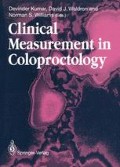Abstract
Although the occurrence of complete prolapse is not usually associated with major constitutional disturbance, the condition can be a source of significant disability, particularly in the presence of anal sphincter and pelvic floor weakness. Detailed and complex investigation of patients with prolapse is generally unnecessary but the study of pelvic floor and anal sphincter function may be useful in predicting function after the prolapse has been successfully corrected by surgery.
Access this chapter
Tax calculation will be finalised at checkout
Purchases are for personal use only
Preview
Unable to display preview. Download preview PDF.
References
Bartram CI, Turnbull GK, Lennard-Jones JE (1988) Evacuation proctography: an investigation of rectal expulsion in 20 subjects without defaecatory disturbance. Gastroint Radiol 13: 72–80
Broden B, Snellman B (1968) Procidentia of the rectum studied with cineradiography: a contribution to the discussion of causative mechanisms. Dis Col Rec 11: 330–347
Bruck CE, Lubowski DZ, King DW (1988) Do patients with haemorrhoids have pelvic floor denervation? Int J Colorect Dis 3: 210–214
Hancock BD, Smith K (1975) The internal sphincter and Lord’s procedure for haemorrhoids. Br J Surg 62: 833–836
Jones PN, Lubowski DZ, Swash M, Henry MM (1987a) Relation between perineal descent and pudendal nerve damage in idiopathic faecal incontinence. Int J Colorect Dis 2: 93–95
Jones PN, Lubowski DZ, Swash M, Henry MM (1987b) Is paradoxical contraction of the puborectalis muscle of functional importance? Dis Col Rec 30: 667–670
Lubowski DL, Swash M, Henry MM (1988) Increase in pudendal nerve terminal motor latency with defaecation straining. Br J Surg 75: 1095–1097
Mahieu PHG (1986) Barium enema and defaecography in the diagnosis and evaluation of the solitary rectal ulcer syndrome. Int J Colorect Dis 1: 85–90
Neill ME, Parks AG, Swash M (1981) Physiological studies of the pelvic floor in idiopathic faecal incontinence and rectal prolapse. Br J Surg 68: 531–536
Read MG, Read NW, Haynes WG, Donnelly TC, Johnson AG (1982) A prospective study of the effect of haemorrhoidectomy on sphincter function and faecal incontinence. Br J Surg 69: 396–398
Rutter KRP (1974) Electromyographic changes in certain pelvic floor abnormalities. Proc R Soc Med 67: 53–56
Skomorowska E, Hegedus V, Christiansen J (1988) Evaluation of perineal descent by defaecography. Int J Colorect Dis 3: 191–194
Snooks SJ, Nicholls RJ, Henry MM, Swash M (1985) Electrophysiological and manometric assessment of the pelvic floor in solitary rectal ulcer syndrome. Br J Surg 72: 131–133
Teramoto T, Parks AG, Swash M (1981) Hypertrophy of the external and internal sphincters in haemorrhoids: a histometric study. Gut 22: 45–48
Thomson WHF (1975) The nature of haemorrhoids. Br J Surg 62: 542–552
Waldron DJ, Kumar D, Hallan RI, Williams NS (1989) Prolonged ambulant assessment of anorectal function in patients with prolapsing haemorrhoids. Dis Colon Rectum 32: 968–974
Womack NR, Williams NS, Holmfield JHM, Morrison JFB, Simpkins KC (1985) New method for the dynamic assessment of anorectal function in constipation. Br J Surg 72: 994–998
Womack NR, Williams NS, Holmfield JHM, Morrison JFB (1987) Pressure and prolapse–the cause of solitary rectal ulceration. Gut 28: 1228–1233
Editor information
Editors and Affiliations
Rights and permissions
Copyright information
© 1991 Springer-Verlag London Limited
About this chapter
Cite this chapter
Henry, M.M. (1991). Rectal Prolapse, Solitary Rectal Ulcer Syndrome and Haemorrhoids. In: Kumar, D., Waldron, D.J., Williams, N.S. (eds) Clinical Measurement in Coloproctology. Springer, London. https://doi.org/10.1007/978-1-4471-1822-0_10
Download citation
DOI: https://doi.org/10.1007/978-1-4471-1822-0_10
Publisher Name: Springer, London
Print ISBN: 978-1-4471-1824-4
Online ISBN: 978-1-4471-1822-0
eBook Packages: Springer Book Archive

